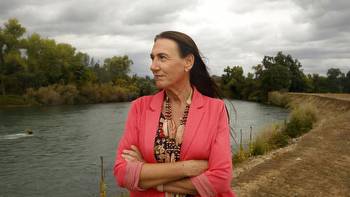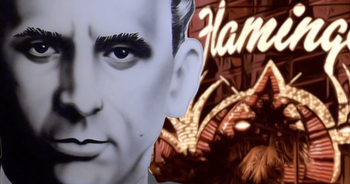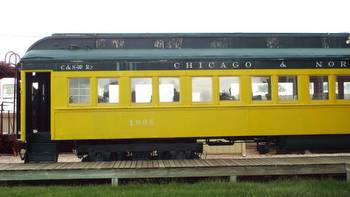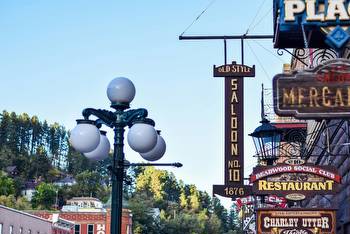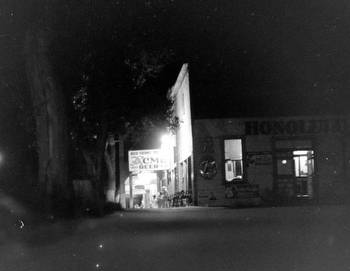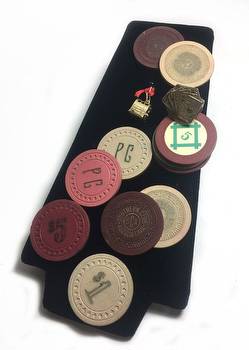Diamond Tooth Gerties: The Story Of Canada's Oldest Casino
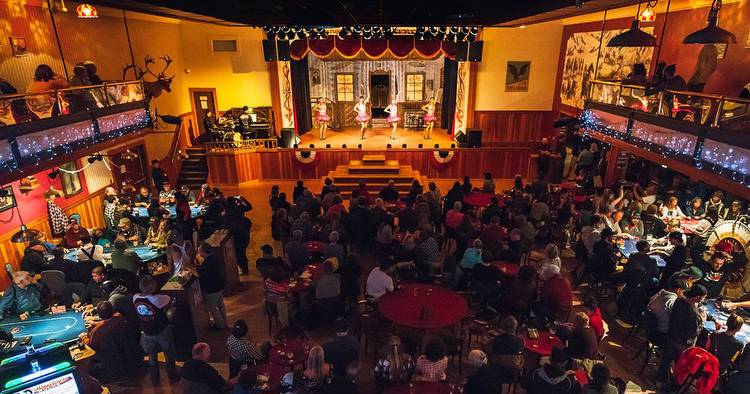
There are nearly 100 land-based casinos in Canada, but gamblers looking for a unique gaming and entertainment experience will want to travel to Canada’s Far North, where you can get into a poker game, drink a shot with a petrified big toe in it, and enjoy watching the Aurora Borealis, also known as the Northern Lights.
Diamond Tooth Gerties Gambling Hall (yes, that’s its name) is located in Dawson City, Yukon, and has the distinction of being Canada’s oldest legal casino.
Since 1971, the venue has been transporting patrons back in time in a town that was considered the heart of the world-famous Klondike Gold Rush, which involved migration of an estimated 100,000 prospectors to the region between 1896 and 1899. With slots, table games, and three different can-can dance shows a night, the saloon-style gambling hall is the entertainment hub for an estimated 60,000 tourists who visit Dawson City each year.
In fact, it’s the only casino in Canada where patrons can gamble, drink alcohol, and watch live entertainment all in the same intimate hall.
And it’s just not the gambling hall that transports visitors back in time. The town of roughly 1,500 people features several preserved frontier-style buildings in addition to breathtaking views of the Yukon landscape, roughly 65 miles from the Alaska border.
Primarily a summer tourist destination, Diamond Tooth Gerties is open five days a week from May-September. It downsizes to a weekend operation during the fall and winter months.
Diamond Tooth Gerties is operated by the Klondike Visitors Association (KVA), a not-for-profit tourism sector organization representing local and regional members and industry stakeholders. Profits from operating Diamond Tooth Gerties are reinvested into the community through grant programs, fundraising opportunities, and sponsorships.
The inspirational dancehall queen
So why is the venue oddly named Diamond Tooth Gerties?
“Diamond Tooth Gertie was a dancehall girl from the Klondike Gold Rush days,” Alex Somerville, executive director at the Dawson City Museum, told US Bets. “She was famous, or infamous, for wearing a diamond between her front teeth. The building itself was built by the Arctic Brotherhood, a fraternal society specific to the north created by people on the boats coming up to Alaska as part of the Klondike Gold Rush.”
Somerville was referring to Gertie Lovejoy, who actually existed, although records and newspapers don’t substantiate her legend.
“She mined the miners, who parted with their hard-earned gold in exchange for her affections,” Yukon historian Michael Gates wrote in a 2014 article, “Diamond Tooth Gertie: From Dance Hall to Prayer Hall.”
Born Mary Isabel Lovejoy in 1874, there are still many unanswered questions surrounding her stay and life in Dawson City. However, there are legal records that she married prominent lawyer Charles W.C. Tabor, raising her profile in the community.
According to the gambling hall’s website, Diamond Tooth Gertie is being played in the can-can show by Amy Soloway, a professional performer originally from Nova Scotia. The Klondike Sun profiled Soloway in 2014, and she spoke in detail about literally filling the local legend’s shoes.
Dawson City’s embedded gambling culture
Gambling was inherent to Dawson City way before the opening of the legal gambling hall in 1972.
Dawson City’s oldest gambling pastime is wagering on when the ice will break up on the Yukon River. Since Dawson City’s official founding in 1896, businesses there have run Yukon River Ice Pools.
“The river freezes, and in the springtime there’s a closing date for when you can place your bets,” Somerville explained. “There’s a marker placed in the ice, and people bet on the day, hour, and the minute that the marker will move.”
In the early days of Dawson City, games of chance like poker, faro, and keno were being played in theaters and saloons around the clock.
“There wasn’t a lot of do. There was very little reading material. People would pass the time by telling stories and making wagers,” Somerville said.
One of the biggest gamblers during early Klondike gold history was an American named Sam Bonifield. Known as “Square Sam” because his gambling was so honest, he ran a saloon that was known as “The Bank” because of the super high-stakes games being played inside by patrons willing to wager mortgages, properties, and hotels.
One of Bonifield’s employees at the time, Tex Rickard, later became the founder of the NHL’s New York Rangers. Rickard rushed to Alaska after the discovery of gold in the region and eventually opened his own saloon and gambling hall in Dawson City, but he lost everything because he had a gambling problem of his own. Rickard then moved on to other business ventures, including boxing promotions and cattle ranching, before founding the Rangers and building the third incarnation of Madison Square Garden.
Despite Dawson City’s history with it, gambling was shut down by the government in 1901, Gates explained to US Bets. He offered the following passage from his soon-to-be released book, Hollywood in the Klondike:
In the early days of Dawson, establishing licenses and fines for saloons, gaming houses and brothels helped finance the infrastructure of the community. The Yukon Act in 1898 established a licensing structure. Hotels paid two thousand dollars per year, saloons, twenty-five hundred, and theatres with bars also required a saloon license. Similarly, when Superintendent Sam Steele of the Mounted Police arrived in Dawson, he established the practice of fining “knights of the green cloth” every month, with the hint to leave town. The gambling fraternity came to regard this as a form of licensing and carried on as usual. Some came to court and paid their fines voluntarily, without waiting for a summons. The Mounted Police wanted a crackdown on gambling, yet they recognized that the saloons, dance halls and theatres were an important part of the local economy, and immediate closure would throw people out of work, causing financial hardship for many prominent businessmen. It was a fine balance, but they kept close watch on activities in the saloons and dance halls, even having undercover agents providing vital information on the bad elements that inhabited them.
The Royal Canadian Mounted Police held, and still hold, jurisdiction over Dawson City. Any games not above board were reported to the police force known in Canada as the “Mounties.”
“The solution for troublemakers was banishment from the gambling hall. If you seemed like, or if you did, stir up trouble, you got the boot,” Somerville said.
Dawson City underwent several transformation periods in the early 20th century due to the decline of the gold rush and then the two world wars, which ravaged the local economy. Locals decided to collectively reinvent the area as a tourist destination, thus forming the Klondike Tourism Bureau. The organization erected several important institutions in Dawson City, including the local museum, and in the 1960s it became the KVA.
In 1971, the local community hall was repurposed into Diamond Tooth Gerties Gambling Hall by obtaining a special gambling license from the Canadian government. But the KVA were amateurs in the business, so they recruited experts from Las Vegas to teach a new staff how to operate a casino and put on a good show.
The Sourtoe Cocktail
Dawson City is known for whiskey, women, gambling, and … the Sourtoe Cocktail.
A rite of passage for any visitor involves drinking a shot of their choice (but usually whiskey) with a petrified big toe at the Sourdough Saloon.
The story of the Sourtoe Cocktail began during prohibition in the 1920s, when two local rum-running brothers got caught in a blizzard. As the tale goes, one of the brothers put his foot through a patch of ice and soaked his foot. By the time they returned to the warm confines of their cabin, the foot was frozen solid and needed to be amputated with an axe. It was then stored to commemorate the event.
In 1973, Captain Dick Stevenson found the jar containing the toe in a remote cabin. He came up with the idea to create an exclusive club with only one membership requirement: “You can drink it fast. You can drink it slow. But your lips must touch that gnarly toe.”
The club had a brief setback in 2013, though, when one man swallowed the legendary toe on purpose. Locals made the man, an American, pay a $500 fine and then leave the region for his heinous act.
Over the years, more than eight toes have gone missing, or been stolen, or destroyed, but this was the only time on record that a toe was purposely vanquished.
The club, which now has over 60,000 members, relies on “donations” in order to keep up supply of its main Sourtoe Cocktail ingredient.
Dawson City a great place to work and play
While backpacking through Central America with some friends after high school, Devan McCannel met a can-can dancer who worked at the Dawson City gambling hall.
“She told us about this town up north, about how fun it was in the summer. We had nothing going on, so we convinced one other friend to join us and we bused up there,” McCannel told US Bets.
Businesses in Canada’s northern regions are constantly battling labor shortages, so many seasonal workers from other provinces are enticed to work, and play, in the north, especially during the busy summer tourist season.
McCannel’s female companion arranged an employment “tryout” for him at the gambling hall, where he was subjected to a one-week crash course in dealing cards. He had no previous experience working in a casino environment, but quickly learned the trade.
“It was one of the highlights of my life,” he said of his tenure there in 2009-10. “It was fun. The sun doesn’t set, you get off work at 2 a.m., you’re with all your friends, and then you go to someone’s place and play poker until 6 a.m.
“And you’re in this amazing wilderness, but in a small town. You can go canoeing on the river, and we did lots of partying, for sure. I don’t know if it’s something about the sun never setting, or people being cooped up inside all winter, but everyone is just having a fun time.”
Due to the Earth’s axial tilt, the sun doesn’t set during the summer months in the Yukon, which can really throw someone off after an evening gambling bender.
McCannel said an interesting mix of tourists and locals visit the casino. Many of the tourists are from Alaskan Cruise ships who do day trips through Dawson City. Others stop in as part of a long road trip through the northern regions of Canada and Alaska. The local miners also “have a lot of cash and nothing to spend it on having a good time.”
One night, he recalled, some very special guests rolled into the casino: actors Jack Black, Steve Martin, and Owen Wilson. The trio were in town filming The Big Year and couldn’t resist the opportunity to play some poker and enjoy the entertainment. (The comedy film is about three friendly rivals who travel to remote areas of North America in a quest to count more bird species than anyone else. It received a weak 42% rating on Rotten Tomatoes.)
A friend of McCannel’s dealt cards to the famous actors, who apparently tipped very well. Wilson even played some soccer with McCannel and his friends the following night in the town.
“It’s such a fun casino — live music, good shows going all night,” recalled McCannel, who now works as head of app partnerships for a company in Victoria, British Columbia. “People are there to have fun, so as a dealer I could be incredibly animated. It just feels different than a Vegas casino, or casinos in British Columbia. The atmosphere was so positive.”
Somerville’s path to Dawson City was similar to McCannel’s. He formerly worked in a museum in Nova Scotia, and at the end of a relationship with a girlfriend, he wanted to move on to a new adventure. He saw a job posting for the museum in Dawson City. He applied, got the job, and 11 years later, he’s still there.
“I just fell in the love with the place,” Somerville explained. “There’s just something about this place that just captures some people and they find themselves attracted to the community and the people. I don’t know what it is. If you could bottle and sell it, you’d be a millionaire.”
Prior to living and working in Dawson City, Somerville had never been to a casino despite calling major cities like Toronto and Halifax home. And although he doesn’t fancy himself a big gambler, the history and theater of Diamond Tooth Gerties is still appealing to him.
“It’s the character that really does make Diamond Tooth Gerties special.”










